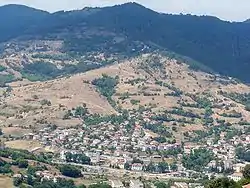Ardino Municipality
Ardino Municipality is a municipality in Kardzhali Province, Bulgaria. It includes the town of Ardino and 51 nearby villages.
Ardino Municipality
Община Ардино | |
|---|---|
Municipality | |
 Ardino | |
| Coordinates: 41°35′N 25°8′E | |
| Country | Bulgaria |
| Province | Kardzhali |
| Municipality | Ardino |
| Area | |
| • Total | 341.45 km2 (131.83 sq mi) |
| Population (1-Feb-2011) | |
| • Total | 13,326 |
| • Density | 39/km2 (100/sq mi) |
| Time zone | UTC+2 (EET) |
| • Summer (DST) | UTC+3 (EEST) |
| Website | www |
.png.webp)
Demographics
As of December 2018, the municipality of Ardino has 12,792 inhabitants. Only 4,002 inhabitants live in the town of Ardino and the remainder in one of the 51 villages.[1]
The following table represents the change of the population in the province after World War II:
| 1946 Census | 1956 Census | 1965 Census | 1975 Census | 1985 Census | 1992 Census | 2001 Census | 2011 Census | 2018 Estimate |
|---|---|---|---|---|---|---|---|---|
| 30,609 | 29,407 | 33,185 | 29,507 | 27,698 | 18,174 | 13,649 | 11,572 | 12,792 |
The municipality of Ardino has lost more than two thirds of its population in a period of seventy years.
Vital statistics
The municipality of Ardino recorded just 66 birth, down from 132 in 2000. At the same time there were 193 deaths, up from 168 deaths in 2000.[2] Demographic trends in the municipality of Ardino have largely been unfavourable.
| Population | Live births | Deaths | Natural growth | Birth rate (‰) | Death rate (‰) | Natural growth rate (‰) | |
|---|---|---|---|---|---|---|---|
| 2000 | 17,898 | 132 | 168 | -36 | 7.4 | 9.4 | -2.0 |
| 2001 | 13,492 | 124 | 148 | -24 | 9.2 | 11.0 | -1.8 |
| 2002 | 13,410 | 103 | 144 | -41 | 7.7 | 10.7 | -3.1 |
| 2003 | 13,236 | 118 | 150 | -32 | 8.9 | 11.3 | -2.4 |
| 2004 | 13,102 | 137 | 136 | 1 | 10.5 | 10.4 | 0.1 |
| 2005 | 12,916 | 126 | 151 | -25 | 9.8 | 11.7 | -1.9 |
| 2006 | 12,686 | 126 | 192 | -66 | 9.9 | 15.1 | -5.2 |
| 2007 | 12,503 | 122 | 153 | -31 | 9.8 | 12.2 | -2.5 |
| 2008 | 12,368 | 122 | 152 | -30 | 9.9 | 12.3 | -2.4 |
| 2009 | 12,128 | 107 | 168 | -61 | 8.8 | 13.9 | -5.0 |
| 2010 | 12,282 | 90 | 132 | -42 | 7.3 | 10.7 | -3.4 |
| 2011 | 11,476 | 81 | 163 | -82 | 7.1 | 14.2 | -7.1 |
| 2012 | 11,412 | 83 | 172 | -89 | 7.3 | 15.1 | -7.8 |
| 2013 | 11,286 | 83 | 170 | -87 | 7.4 | 15.1 | -7.7 |
| 2014 | 11,956 | 78 | 159 | -81 | 6.5 | 13.3 | -6.8 |
| 2015 | 12,377 | 89 | 168 | -79 | 7.2 | 13.6 | -6.4 |
| 2016 | 12,424 | 85 | 177 | -92 | 6.8 | 14.2 | -7.4 |
| 2017 | 12,630 | 100 | 177 | -77 | 7.9 | 14.0 | -6.1 |
| 2018 | 12,792 | 66 | 193 | -127 | 5.2 | 15.1 | -9.9 |
Ethnic composition
A majority of the population consists of ethnic Bulgarian Turks (71.2%).[3] Ethnic Bulgarians make up around 26.9% of the population. Most of those Bulgarians are Pomaks.
Religion
According to the latest Bulgarian census of 2011, the religious composition, among those who answered the optional question on religious identification, was the following:
Both ethnic Turks and Bulgarians are predominantly Islamic by faith.
References
- "Population by districts, municipalities, place of residence and sex | National statistical institute". www.nsi.bg. Retrieved 2018-02-06.
- "Deaths by districts, municipalities and sex | National statistical institute". www.nsi.bg. Retrieved 2018-02-07.
- "Ethnic composition of Bulgaria 2011". pop-stat.mashke.org. Retrieved 2018-02-07.
- "Religious composition of Bulgaria 2011". pop-stat.mashke.org.
